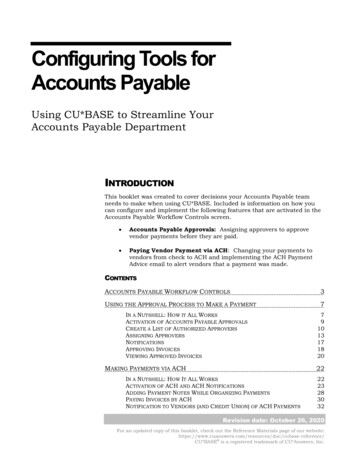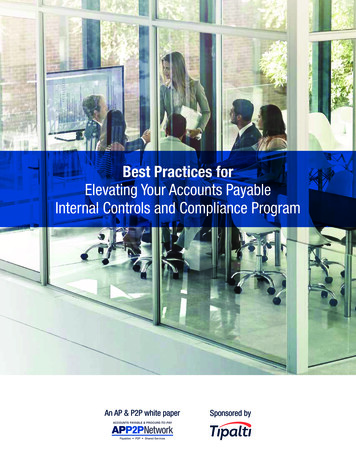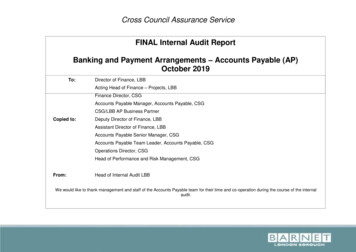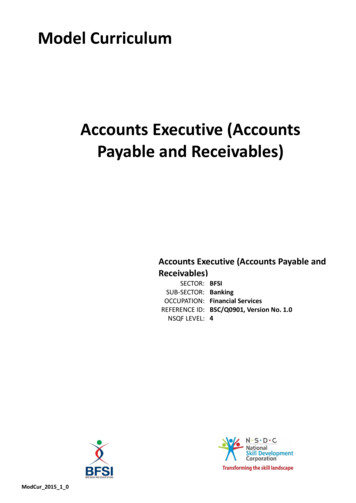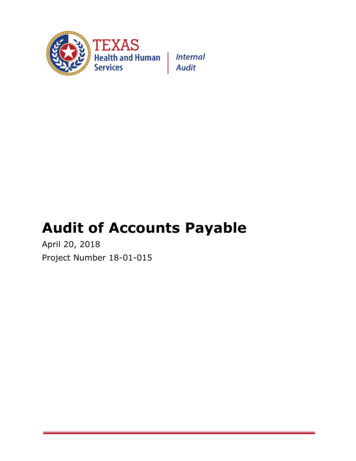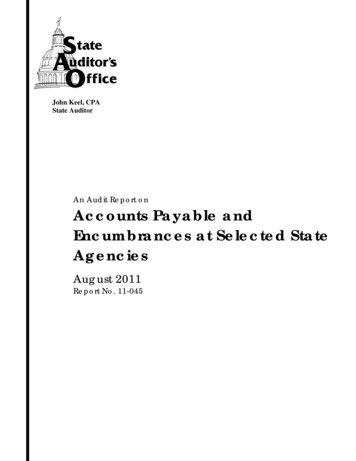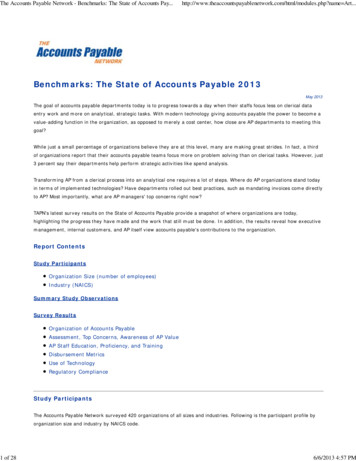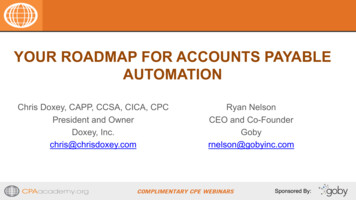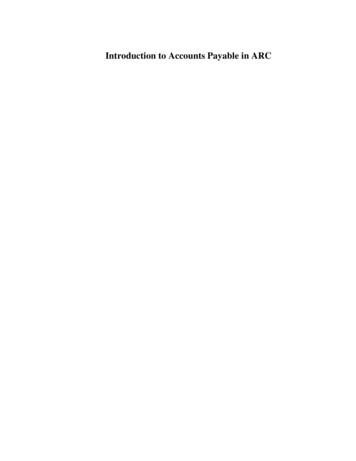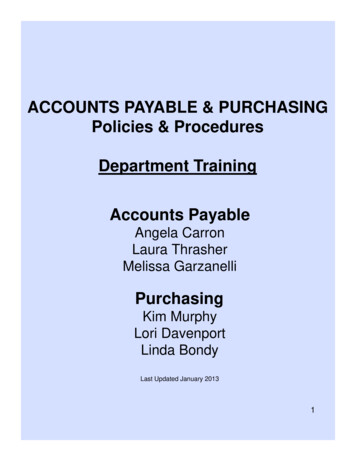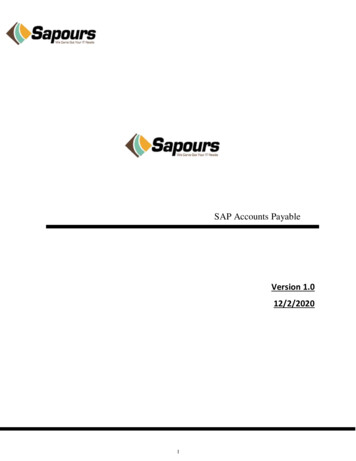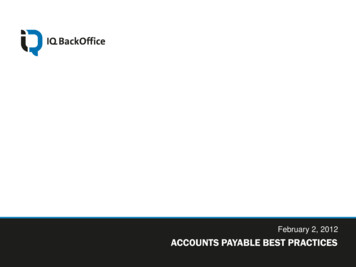
Transcription
February 2, 2012ACCOUNTS PAYABLE BEST PRACTICES
IMPORTANCE OF A/P BEST PRACTICES– After payroll, the largest disbursement of a firm’s funds typically comes from AccountsPayable (A/P)– Accounts Payable is often the largest single cost in the accounting function– The typical Accounts Payable process is notorious for its manual, inefficient and errorprone nature, which leads to Errors: The average Accounts Payable department has a 1.6% error rate* High Cost: The average cost to process an invoice is 16.54* Lack of Controls: Clerical staff have broad discretion on how to apply managementrules around PO/receipt/invoice matching and payment and invoice authorizationrules are not always followed Poor Visibility: Financial managers accrue outstanding payables monthly; many of theindividual transactions are paper invoices sitting in manager inboxes waiting forapproval that financial managers have not seen Poor Documentation: The paper-intensity of the process leads to difficulty in locatingmanually-filed invoice and check documents Management Intensity: All of the above contribute to an excessive amount ofmanagement time, attention and resources to a non value-added functionAccounts Payable Best Practices 2002-2012, IQ BackOffice, Inc.2
IMPORTANCE OF A/P BEST PRACTICES– Best practice Accounts Payable costs significantly less than the typical process The average cost to process an invoice is 16.54* A/P can be processed as much as 50 times more efficiently than others (32 ) Continuous improvement continually reduces cost while improving quality andservice levels– Sarbanes-Oxley Section 404 Requires Management To Acknowledge Its Responsibility– For The Adequacy Of A Company’s Internal Control Structure And ProceduresFor Financial Reporting– To Assess The Effectiveness Of A Company’s Internal Control Over FinancialReporting, With The Company’s Independent Auditors Being Required To AttestTo Management’s Internal Control Report Annual reports must contain management’s report on internal controls and theauditor’s attestation of management’s assessment Management must evaluate on a quarterly basis material changes in the company’sinternal controls Quarterly disclosure requirements include effectiveness of controls and proceduresand changes in internal controlsAccounts Payable Best Practices 2002-2012, IQ BackOffice, Inc.3
BEST PRACTICES: QUALITYIssue / Description Data Entry ErrorsData Entry Errors Can Occur on Any Invoice Fieldand Account for Most of the Errors in AccountsPayableData Entry Errors Average 1.6%, a Very LargeAmount Not Readily Measurable in MostAccounting Departments Best Practice Matching Errors Matching of Invoices to Purchase Orders andReceipts is Complex and Prone to Errors Business Rules for Matching are Frequently NotDocumented or Followed by Clerical Staff Accounts Payable Best Practices 2002-2012, IQ BackOffice, Inc.Receipt of Electronic Invoices (EDI, XML, etc.)Eliminates Data Entry EntirelyMatching to Purchase Orders in an AutomatedAccounting System Eliminates the Need forMuch Data EntryData Entry by One Individual and Quality Reviewby a Different Individual Eliminates Almost AllData Entry ErrorsDouble Entry of Invoices with Field by FieldComparison Eliminates Almost All Data EntryErrorsAutomated Matching in Accounting System(Typically Found in High-End ERP Systems Only)Well-Documented Business Rules AroundMatching (What Constitutes a Match, Field byField) and Action to Take if There is an ExceptionLogs of Exceptions by Exception Type, Sent toPurchasing Department for Vendor Follow-Up4
BEST PRACTICES: QUALITYIssue / Description Duplicate or Incorrect InvoicesVendors Frequently Generate DuplicateInvoices When an Invoice Has Not BeenPaid in a Timely Manner Improper Account CodingAccount Coding is Judgmental and Rulesfor Coding are Not Well Documented orOtherwise Established in Most Companies;This May Lead to Inconsistent CodingAcross Departments or Manipulation forBudgetary or Other PurposesAccounts Payable Best Practices 2002-2012, IQ BackOffice, Inc.Best PracticeAccounting System (Or Individual ifManual Process) Should Check forDuplicate Invoices by Invoice Number Accounting Should Check that an Invoiceis For The Correct Company and BusinessUnit Duplicate or Incorrect Invoices Should beLogged So That the Source of ProblemsCan Be Found Well Documented Business Rules AroundCoding Review of Coding by Managers to EnsureBusiness Rules are Followed Greater Use of Purchase Orders EliminatesNeed for Account Coding by Managers 5
BEST PRACTICES: CONTROLSIssue / Description “Disappearing” Invoices and UnapprovedInvoicesInvoices that Come Directly from theVendor to a Business Unit Manager orLocation Other than Accounting Tend toGet Delayed (Sometimes on Purpose) orLost Due to the Many Opportunities forPaper to Get LostUnapproved Invoices (Not Yet Received byAccounting) are Not Known to Accountingand Therefore Company Liabilities are NotTruly Known or Reflected on the BalanceSheetAccounts Payable Best Practices 2002-2012, IQ BackOffice, Inc.Best PracticeAll Invoices Should Come in to a CentralLocation and Scanned or, at a Minimum,Logged Before Being Sent for Approval Logging of Invoices Provides the CFO Witha True Picture of the Liabilities of theCompany Invoice Images Should be RoutedElectronically for Approval to TrackInvoices at Each Step of the Process andEliminate Managers “Sitting” on Invoicesin Their InBox 6
BEST PRACTICES: CONTROLSIssue / Description Lack Of Well-Defined and DocumentedPO-Receipt-Invoice Matching Business RulesIn Most Companies, Matching Business Rules areNot Documented in Writing or in Complete Detailand Accounting Systems are Incapable ofMatching Automatically Using All NecessaryRules, Forcing Accounts Payable Staff to ApplyRules Manually Excessive Use of PO-Receipt-Invoice MatchingTolerancesBest Practice Many Accounts Payable Departments UseMatching Tolerances to Reduce the Effort toResolve Unmatched Items, But Are Often Set TooLoosely (to Reduce Effort), Allowing Dollars to beLostAccounts Payable Best Practices 2002-2012, IQ BackOffice, Inc.Document All Matching Business Rules inComplete DetailAutomate Application of Business Rules Utilizinga Combination of Accounting Systems, ThirdParty and Proprietary Software SolutionsLow to No Use of TolerancesAnalysis of Effort in Resolving Unmatched Itemsvs. Dollars Lost to Determine the ProperTolerance Levels7
BEST PRACTICES: CONTROLSIssue / Description Broad Discretion of Application of PO-ReceiptInvoice Matching and Approval Level BusinessRules by Accounts Payable StaffAccounts Payable Staff Apply Rules Manuallyand Generally Have Broad Discretion on How toApply Business Rules; Few Companies AuditRules ComplianceBest Practice Approval of New Vendors or Update of Key VendorInformation Document All Matching Business Rules inComplete DetailTrain Management and Accounts Payable Staffon Business RulesAudit Compliance of Business RulesReturn Invoices without Account Coding orImproper Coding to Approver/Buyer for CorrectCodingAutomate Application of Business Rules Utilizinga Combination of Accounting Systems, ThirdParty and Proprietary Software SolutionsPurchasing Department Should Approve All NewVendors and Changes to Existing Vendor RecordsCareful Controls Should be Placed On Who CanApprove the Establishment or Revision ofVendors to Prevent FraudAccounts Payable Best Practices 2002-2012, IQ BackOffice, Inc.8
BEST PRACTICES: VISIBILITYIssue / Description Financial Management Does Not Know the TruePicture of Outstanding Company LiabilitiesMany Invoices are in Manager’s InBoxes orRemote Locations at Any Point in Time;Financial Management Has No Way of Knowingthe Dollar Value and Due Dates of TheseInvoices Managers Keep Invoices in Their InBoxes TooLong or Misplace ThemManagers Inadvertently or Deliberately (to AvoidCosts Hitting Their Cost Center) Do Not Approveor Reject Invoices on a Timely Basis or LoseThem; Financial Management Has No Way ofKnowing the Dollar Value and Due Dates ofThese InvoicesBest Practice Centralize Receipt of Invoices at a CentralLocation and Route Electronically for ApprovalUsing Workflow TechnologyDevelop a Report at the End of the Month forFinancial Management to Accrue AllOutstanding Liabilities AccuratelyCentralize Receipt of Invoices at a CentralLocation and Route Electronically for ApprovalUsing Workflow TechnologySet Business Rules for Managers to Approve orReject All Invoices within 2 days of Receipt orLessThis Also Leads to Poor Credit From Vendors,Late Charges or Inability To Take Advantage ofDiscountsAccounts Payable Best Practices 2002-2012, IQ BackOffice, Inc.9
BEST PRACTICES: DOCUMENTATIONIssue / Description Difficult to Find Invoices and Checks AfterProcessing and Document Storage isExpensiveBest PracticeUtilization of Imaging Systems Integratedinto Accounting System Elimination of Paper Files Paper Documents are Difficult to LocateAfter Accounts Payable Processing Due toFiling Errors and Are Expensive to Store andLocateMany Companies Store the Invoice, a Copyof the Check and Purchase Order Togetherfor Ease of Retrieval, But This is ExtremelyExpensiveAccounts Payable Best Practices 2002-2012, IQ BackOffice, Inc.10
BEST PRACTICES: MANAGEMENT INTENSITYIssue / Description Accounts Payable is ManagementIntensive, Complex and VoluminousBest Practice Outsourcing of Accounts PayableProcessesAccounts Payable is a TransactionProcessing Function, Not Really anAccounting FunctionThis Means that Accounts PayableRequires More Management Time andEmployee Supervision (“Fire Fighting”),More Technology and Capital Than OtherFinancial ProcessesManagement Techniques for AccountsPayable Also Differ Markedly FromAccounting Functions and Requires MoreManagement TrainingAccounts Payable Best Practices 2002-2012, IQ BackOffice, Inc.11
BEST PRACTICES:EFFICIENCY & CONTINUOUS IMPROVEMENTIssue / Description Accounts Payable Process Efficiency and CostSome Firms Employ Best Practices That ReduceAccounts Payable Processing Costs To As Low As 0.32 Per InvoiceBest Practice Accounts Payable Best Practices 2002-2012, IQ BackOffice, Inc.Detailed Matching and Approval Business RulesNo Invoice Accepted Without A Purchase OrderNo Invoice Accepted On Paper; All Invoices MustBe ElectronicScan All Remaining Paper InvoicesEvaluated Receipts Settlement (DisbursementMade Upon Receipt Of Goods Based On POPricing; Invoices Irrelevant)Use Of Procurement Cards For Low DollarPurchasesUtilization of Workflow to Electronically RouteInvoices for ApprovalWeb-Based Invoice Processing and PaymentStatus for Vendor Self-ServiceCall Center to Handle Vendor Phone CallsShort Pay Invoices as Appropriate But ItemizeDeductions to Prevent Confusion by VendorsTake Deductions Wherever Possible12
BEST PRACTICES:EFFICIENCY & CONTINUOUS IMPROVEMENTIssue / Description Continuous ImprovementGather Pertinent Data and Analyze It toContinually Improve the Accounts PayableProcessAccounts Payable Best Practices 2002-2012, IQ BackOffice, Inc.Best PracticeRevise the Accounts Payable Process toTake Advantage of New Techniques or toCorrect the Cause of Problems Investigate and Implement NewTechnologies to Further Enable theProcess Implement Accounts Payable ReportingSystem to Better Measure and Managethe Process and Report on the Followingin Real-Time: Exceptions by Field, Type ofException, and Invoice; Status of Invoicesat Each Step of the Process; Cycle Times;and Cost Manage the Process Tightly, Paying CloseAttention to Metrics Gathered in theReporting System Begin the Continuous ImprovementProcess Again 13
BEST PRACTICES: SARBANES-OXLEYIssue / Description Sarbanes-Oxley ComplianceEnsure Effective Internal Controls, AllowManagement to Ensure the Adequacy andAssess the Effectiveness of Those Controlsand Procedures, and Allow the Auditors toAttest to Management’s Internal ControlReportBest PracticeDocument All Invoice Matching andApproval Business Rules in CompleteDetail Utilize Well Documented Business RulesAround Coding Utilization of Workflow to ElectronicallyRoute Invoices for Approval Utilization of Imaging Systems Integratedinto Accounting System Centralize Receipt of Invoices at a CentralLocation Develop a Report at the End of the Monthfor Financial Management to Accrue AllOutstanding Liabilities Accurately Automate Application of Business RulesUtilizing a Combination of AccountingSystems, Third-Party and ProprietarySoftware Solutions Accounts Payable Best Practices 2002-2012, IQ BackOffice, Inc.14
EXAMPLE OF ACCOUNTS PAYABLE BEST PRACTICES:THE IQ BACKOFFICE PROCESS
A BEST PRACTICE SOLUTIONCUSTOMIZED FOR EACH CLIENTTHE IQ SOLUTIONHAS THE ESSENTIALCOMPONENTS OF AWORLD-CLASSACCOUNTS PAYABLEPROCESS:Supplier ProvidesGood / ServiceSupplierSends InvoiceIQ Opens Mail andScans InvoicesIQ Indexes &Matches Invoice& IdentifiesExceptionsElectronic InvoiceIQ Answers Supplierand Client PhoneCalls &CorrespondenceShared Service Center Utilizing: Industry Best Practices SAS70 Controls Complete Audit Trail for Each Invoice Dedicated Client Teams Real-Time Management Reporting forComplete ControlClient Manager(s) ApproveInvoice & Resolve ExceptionsOnlineIQ Vouchers Invoice inClient Accounting SystemIQ Prints and Mails Checks,Wires & ACH PaymentsClient Approves Payments inClient Accounting SystemAccounts Payable Best Practices 2002-2012, IQ BackOffice, Inc.IQ Performs 100% Audit16
CONTINUOUS IMPROVEMENT PROCESSIQ Accounts Payable ProcessVirtuous CircleAccounts Reduced CostHigher QualityFaster Cycle TimeEmployee EfficiencyCustomer ServiceApplicationOfTechnologyAccounts Payable Best Practices 2002-2012, IQ BackOffice, Inc.17
WEB-BASED A/P REPORTING Web-Based Reporting & “Drill-Down” Provides Managers with GreaterAccess to Information and Control Over the Business Than They Ever Had:– Customized reports on expenses– “Drill-Down” to the transaction and associated source document image– Reports generated real-time, reflecting changes in the business dynamically– Cost effective – available to all managers, employees, associates, clientsand vendors without per user fees– Easy to use – Web-based requiring one to two hours of trainingAccounts Payable Best Practices 2002-2012, IQ BackOffice, Inc.18
IQ BackOffice2121 Rosecrans Ave., Suite 3350El Segundo, CA 90245www.iqbackoffice.com
BEST PRACTICES: QUALITY Issue / Description Best Practice Data Entry Errors Data Entry Errors Can Occur on Any Invoice Field and Account for Most of the Errors in Accounts Payable Data Entry Errors Average 1.6%, a Very Large Amount Not Readily Measurable in Most Accounting Departments Receipt of Electronic Invoices (EDI, XML, etc.)
